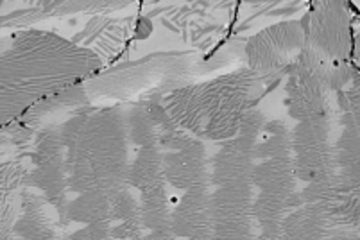All genres
21.
Talk
Investigation of nano-sized kappa carbide distribution in advanced austenitic lightweight high-Mn steels by coupled TEM and DDD simulations: Strengthening and dislocation-based mechanisms. 2nd International Conference on High Manganese Steels, Aachen, Germany (2014)
22.
Talk
Recent development of modelling techniques in nano- and meso-scale simulations of dislocation dynamics. Workshop on Integrated Computational Materials Engineering (ICME), Rolduc Abbey, The Netherlands (2014)
23.
Talk
Modelling of dislocation propagation during creep of single crystal Ni-base superalloys. Eurosuperalloys 2014, Giens, France (2014)
24.
Talk
Mesoscale modelling of the influence of loading conditions on the dislocation mobility and creep process in single crystal Ni base superalloys. KTH Stockholm-Sweden, Stockholm, Sweden (2014)
25.
Talk
Discrete Dislocation Dynamics Study of Creep Anisotropy in Single Crystal Ni Base Superalloys. MRS Fall Meeting, Bosten, USA (2013)
26.
Talk
Molecular Dynamics Study of Obstacle Induced Hardening; From Nano-Sized Defects to Binary Junction. MRS Fall Meeting, Bosten, MA, USA (2013)
27.
Talk
Atomistic study of forest hardening through binary dislocation junction in bcc-iron. 2013 MRS Spring Meeting, San Francisco, CA, USA (2013)
28.
Talk
Scale-hoping approaches in desiging complex alloys. Royal Society International Seminar, Superalloys to Order' at the Kavli Royal Society International Centre, Chicheley, UK (2013)
29.
Talk
Discrete dislocation dynamics modeling of loading orientation effect on the low stress creep of single crystal Ni base superalloys. Intermetallics 2013, Bad Staffelstein, Germany (2013)
30.
Talk
Primary creep of Ni base supealloys used in hot gas turbine blades. Alstom Company, Baden, Switzerland (2012)
31.
Talk
Dislocation dynamics modeling of the glide-climb mobility of a ½ a0<110>{111} dislocation in interaction with γ’ precipitate in Ni-based superalloy. 4th International Conference on Dislocations, Budapest, Hungary (2012)
32.
Talk
Dislocation dynamics simulation: Methodology and applications. Tabriz University, Tabriz, Iran (2012)
33.
Talk
Perspective of multiscale simulation approach in the development of novel materials. Tarbiat Modares University, Tehran, Iran (2012)
34.
Talk
Atomistic simulation and transmission electron microscopy of obstacle strengthening in iron. Sahand University of Technology, Tabri, Iran (2012)
35.
Talk
Effect of local stress state on the glide of ½a₀<111> screw dislocation in bcc-Fe. 1st Austrian-German Workshop on Computational Materials Design, Kramsach, Austria (2012)
36.
Talk
Atomistic modeling of the mobility of the ½a0<111> screw dislocation in iron. E-MRS Fall Meeting, Warsaw, Poland (2011)
37.
Talk
Study of iron EAM potentials and their effects on dislocation dynamic. E-MRS Spring Meeting, Nice, France (2011)
38.
Talk
Simulation of the screw dislocation mobility in Fe by molecular dynamics. E-MRS Spring Meeting, Nice, France (2011)
39.
Talk
Dislocations mechanisms in bcc-Fe; from atomistic to TEM observation. Workshop on ab initio Description of Iron and Steel: Mechanical properties, Ringberg Castle, Germany (2010)
40.
Poster
Modeling of dislocation mechanisms and the influence of the γ/γ´lattice misfit on the dislocation assisted creep of high temperature Ni-base superalloys. 7th International Conference on Multiscale Materials Modeling , Berkeley, CA, USA (2014)











